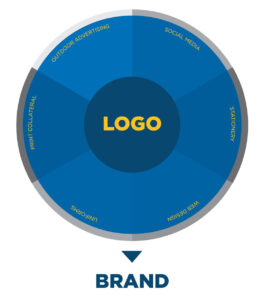
By Dan Antonelli
Posted on Friday, September 26th, 2025
Most sign makers today are actively engaged in brand building for the clients they’re working for. They’re developing logos, signage, point of purchase displays, truck lettering and wraps—maybe more. They’re helping to build brands for these small businesses who hire them. Most are charging for the logo (and if they’re not, they should be).
But are they considering the value of the brand they’re building? Does the client even understand the concept of a brand? Is the shop doing a good enough job educating them on why their brand is their most valuable asset?
Branding 101
There are many definitions of branding, depending on what book you read. Most are along these lines:
■ A brand is what people feel about your company.
■ A brand is what people say about your company behind your back.
■ A brand is the perception or image of your company.
■ The brand is what sets the tone for your company’s external communication and internal culture.
All of these statements are true. I agree with what Marty Neumeier says in his book, Zag: “A brand is a customer’s understanding about a product, service or company. It’s not what YOU say it is, but what THEY say it is.”
How the logo relates to the brand is simple. Much like a bicycle wheel with many spokes, the spokes need to attach to a hub. The logo is the hub that the brand is built around.
So when it comes to designing a logo, and then signage and other applications, the logo lays the foundation to deliver a positive brand promise for the business it represents. As designers, your job is to establish a positive first impression of that business and what they represent.
How to market the concept of branding
Marketing the importance of branding starts with educating clients on what a brand is and why it’s crucial to their success. The beginning of the education starts with discussions about the direction the brand should take when it’s being created, the demographic groups you’re trying to appeal to, and the overall theme of the design.

For any small business, the logo becomes the most critical component of their brand. It’s responsible for driving the creative design for all the other components. The logo sets the tone for the message and the brand promise. It’s the core component of a brand, from which all the brand touchpoints need to be coordinated. Without this strong foundation or “hub”, the brand cannot be fully developed or expanded upon. This is why it’s crucial to start with a proper logo—one that signals the brand promise and value proposition of the company. In the absence of a strong logo with those assets, you’ll always be fighting to overcome what the logo communicates.
This helps to get the client thinking about the core message their brand should communicate. But more importantly, it also frames you as someone who is thinking holistically about their image—not looking to “just make a sign.” This represents an important point of distinction between your shop and others—and it’s probably not what the other shops might be saying to the same client. Now you’re an advocate for your client. Not just a vendor, but more of a partner.
But getting to this point and having a client trust you to undertake this takes time and, of course, good marketing. You need to illustrate to them what the concept of a brand is, and back it up with great examples of your work showing a brand implementation.
Successful case studies are so important to a prospect. They can identify with the other client, and they can visually see how that brand is implemented. And if your case study includes metrics, that can be even more powerful, especially ones that speak to a specific ROI [return on investment]. An example would be saying, “ABC Company tells us that this new truck lettering generated an increase of xx% in phone calls….”
Many sign companies make the mistake of talking so much about themselves in their marketing that they never get to the part of explaining why they’re a smart choice for a business owner. At the end of the day, the customer cares about themselves and what you can do for them.
If I’m a customer, I don’t care how great you say you are. All I care about is how your “greatness” is going to make my life easier, help me make more money, and solve my marketing challenges. If you can’t illustrate that to your customer, then I’m sure there’s someone else doing a better job marketing to them and they are taking that business away from you.
Focus your marketing messages on having the clients see themselves. And the best way to do that is to illustrate the success your efforts have had for clients just like them.
Be different
With the abundance of sign shops selling what appears to be the very same thing, what will you do to set your shop apart? By thinking strategically about the value you can bring to your clients with branding ideas, you’ll set the stage for a different experience and expectation than they’re used to.
Portions of this article were excerpted from Building a Big Small Business Brand, which is available at www.signcraft.com.
This appeared in the January/February 2015 issue of SignCraft.